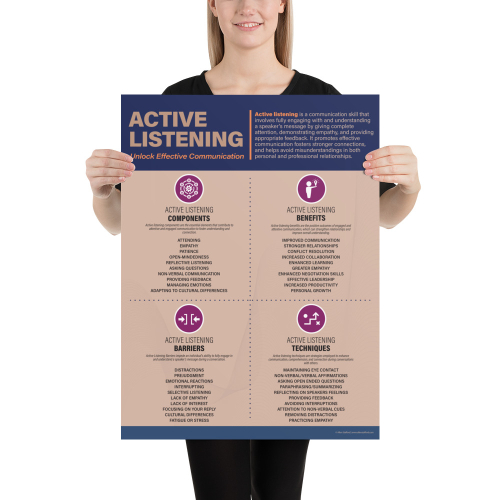In today’s fast-paced and digitally-driven world, we often find ourselves surrounded by distractions that make it difficult to truly connect with others. We may be physically present in a conversation, but our minds are preoccupied with countless thoughts, notifications, and the constant urge to multitask. In this chaos, an essential skill often overlooked is the art of active listening.
I, too, have fallen into the trap of passive listening, where my mind wanders and I only half-heartedly engage in conversations. But over time, I realized the importance of active listening not only in building stronger relationships but also in fostering personal growth and understanding.
Active listening is about more than just hearing words; it’s about fully immersing ourselves in the conversation, being present, and truly understanding the message being conveyed. It requires effort and intentionality, but the rewards are profound.
One of the most significant benefits of active listening is that it helps us develop a deeper level of empathy. When we actively listen to someone, our focus shifts from thinking about our own response to genuinely understanding the other person’s perspective. We begin to see the world through their eyes, allowing us to connect on a much deeper level. By being fully present in the conversation, we can pick up on subtle cues, such as body language and tone of voice, which provide additional insight into the speaker’s emotions and underlying needs.
Not only does active listening enhance our relationships, but it also promotes personal growth. Through active listening, we expose ourselves to different viewpoints and experiences, which can challenge our preconceived notions and expand our understanding of the world. It allows us to shed our ego and approach conversations with a genuine desire to learn and grow.
So how can we become better active listeners? Here are a few strategies that have helped me along my journey:
1. Be fully present: When engaging in a conversation, put away distractions, silence your phone, and give your undivided attention to the person speaking. By being fully present, you send a clear message that the conversation is important to you and show respect for the speaker.
2. Maintain eye contact: Eye contact is a powerful tool that conveys interest and attentiveness. By maintaining eye contact, you are non-verbally reassuring the speaker that you are engaged and interested in what they have to say.
3. Practice mindful listening: Mindful listening involves focusing on the speaker’s words, body language, and tone. Avoid interrupting or thinking about your response while the person is still speaking. Instead, give them space to express themselves fully before formulating your own thoughts.
4. Ask open-ended questions: Open-ended questions encourage conversations to go deeper and allow the speaker to share more details. They demonstrate your genuine interest in understanding the speaker’s perspective rather than simply seeking confirmation of your own thoughts.
5. Reflect and paraphrase: To ensure comprehension and show your engagement, try reflecting and paraphrasing what the speaker has said. This technique can help clarify any misunderstandings and make the person feel heard and understood.
6. Be mindful of non-verbal cues: Pay attention to the speaker’s body language, facial expressions, and tone of voice. Non-verbal cues can provide valuable insights into their emotions and thoughts, allowing for a more complete understanding of their message.
7. Practice empathy and suspend judgment: Active listening requires us to put aside our own biases, assumptions, and judgments. Instead, approach the conversation with empathy and an open mind, seeking to understand the speaker’s perspective without immediately jumping to conclusions.
Incorporating active listening into our daily lives may take practice and patience, but the rewards are well worth the effort. By investing in this skill, we can build stronger relationships, foster personal growth, and create a more empathetic and understanding world.
Next time you find yourself in a conversation, remember the power of active listening. Put away distractions, be fully present, and genuinely engage with the speaker. The rewards of deeper connections, personal growth, and understanding await you.
